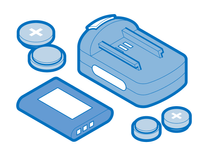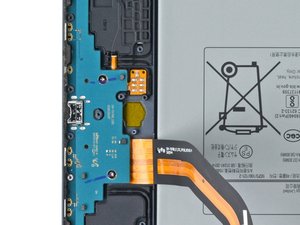Introduction
Although battery life complaints are more typical, a device that takes forever to charge can be equally frustrating. Luckily this is typically a simple fix.
First Steps
Before undertaking any of the more time consuming solutions below, these are a few fundamentals to get you started.
- Try a different charger. This may be as simple as a bad cable or power adapter.
- Restart your tablet. This can clear any minor software hiccups.
- Is your tablet also getting really hot? Even when it’s not charging? This might be an issue with a buggy app.
Causes
Ever notice all the text printed on power adapters? The information here is not just model number and manufacturer data; it also includes the adapter's specifications–what voltages can it change to what? The amount of power the charger can output is strongly related to the rate a device can charge.
- Look for this text on the part of your charger that goes into the wall. It should contain several important bits of information.
- Input Voltage: Not specifically important in this case, but it is typically the first item in the string of things you’re looking for. It will likely indicate 100-240V AC.
- Output Voltage and Amperage: These will be listed together. The adapter may be capable of outputting multiple voltages, including 5V DC, which is the typical voltage for USB charging. Higher voltages may be utilized on larger devices, or to support fast charge standards. Each individual voltage should have a correlating Amp rating.
- Wattage: Some manufacturers, like Apple, list this right on the adapter. If not, calculate it yourself! Wattage is simply Volts multiplied by Amps. In the case of a basic Apple iPhone charger, the USB brick is rated for 5V and 1A. Therefore it would be a 5 Watt charger (5x1=5).
- Save some brain cells and use a wattage calculator if your numbers aren’t as easy.

The higher the wattage of the charger, the faster your tablet has the potential to charge. Tablets generally need a higher wattage for effective charging due to greater power consumption rates.
- Tablets inherently require more power than a Galaxy phone due to the size of components. They require at least a 10 Watt charger in most cases. Connecting less than this may result in a “Not Charging” or “Slow Charging” message.
- This means the tablet knows a charger is present, but it can’t provide enough power to charge the battery. The battery may even drain depending on workload.
Although iPhones are significantly more susceptible to this, Galaxy Tabs and other Samsung tablets will collect debris in their charge ports. It’s an expected side effect of everyday use. If any speaker or microphone grilles are clogged with dust, chances are your charge port is too.
- Check to see if the charge port is clean. Does a cable sit flush against the bottom edge? If it sits at an angle or has a loose fit, the port itself may be clogged. Use a flashlight to inspect.
- Removing debris from ports can be a bit tricky due to narrow clearance. Use an air duster and a toothpick shaved to fit to avoid doing damage. Other non-conductive tools can be used in place of a toothpick, but avoid inserting anything metal into the port.
- If you note damage to the port during cleaning, the port itself is more likely the issue.

$5.99
4.9
264 reviews

$14.95
4.8
192 reviews
Poorly optimized or buggy software can be a battery killer. If the onset of your battery issue is sudden, it may be that an app updated or your tablet installed a patch. The newer version could contain more resource-intensive features, or a bug that unintentionally runs your battery dry.
- Have any apps updated recently? In the Play Store, open the menu by tapping your avatar (or initials). App management will have its own submenu that will list recent updates.
- Check battery usage in the Battery menu within Settings. Galaxy Tabs will have a breakdown of power utilization size last charge. Anything obviously sucking down juice will be listed at, or near the top.
- Quit any app that seems a likely offender and see if it affects battery life.
- If that doesn’t help uninstall any apps that seem likely to be at fault. If battery life improves, try reinstalling the app.
- A fresh OS install is a drastic measure to address battery life, but it could still be helpful, especially if some corruption is contributing to the issue.
- This will remove any data on your tablet. Be sure to have a backup of your device before proceeding. A reset can be performed within settings, but specific location varies by model. Do a search within settings to find it if you are not familiar.
If you’ve cleaned all the gunk out of the port, or everything looked spotless from the start, but it’s still taking ages to charge, the port might be faulty.
- Does your cable only work if you get it in the proper position? Does this persist with other known good cables? Chances are the port is worn or damaged. Your best bet here is to replace the charge port assembly.
- Perform a visual inspection of the device’s internals. Look for any sign of damage. Tears are unusual if the device has never been repaired before, but it’s possible.
- Faults in the charge port can often be attributed to liquid entry. Galaxy tablets are not typically rated for water resistance. The bottom edge specifically has plenty of places for water to get in.
- Replace the part for your specific model if you determine your port needs replacement. Most are part of a daughterboard, or cable assembly.

Find compatible replacement parts for your Samsung Tablet. All parts and fix kits are backed by the iFixit Quality Guarantee.
Unlike the AA Alkaline batteries you put in your TV remote, the battery in your Galaxy Tab. is a little more complex. In addition to the battery cells, where all the energy generating chemistry occurs, the battery also contains a management board. Certain types of failures within this board could cause slow charging.
- Galaxy Tablets do not get the same “Battery Health” data that iPhones now have baked so you’ll need assistance from a third-party tool to get any data about your battery's status.
- If you are not convinced of your battery’s good health, get a second opinion. Many apps to measure battery status are available in the Play Store. Although they are not always entirely accurate, they might get you some numbers to better assess.
- Check for signs of battery swelling. Is the screen bowing outward or separating from the housing? Are there points of discoloration on the screen? These can indicate your battery has reached the end of its life or failed suddenly.
- If any of the above point towards battery failure, install a new one and restest.

Find compatible replacement parts for your Samsung Tablet. All parts and fix kits are backed by the iFixit Quality Guarantee.
The motherboard is the hub for most of a Galaxy Tab’s functionality. Any number of the small components on the board may have failed or become damaged. It is a safe assumption of cause if nothing else on this page has worked.
- Check for obvious signs of a board issue - burned or cracked components, liquid residue, corrosion, or bend. If there are signs of liquid, the iPhone Liquid Damage Guide might help.
- Replacing the logic board is often the most practical solution for a DIYer whose board has failed.
- Contrary to popular belief, the board itself can be repaired. However, it requires specialized tools and microsoldering know-how. If you’re curious and want to know more about getting into micro soldering, here’s some good reading and some good watching to get you started.

- 1 hourModerate
You're seeing solutions for Samsung Tablet. Select your model to find parts for your device.



